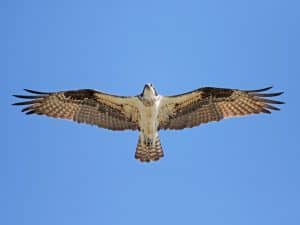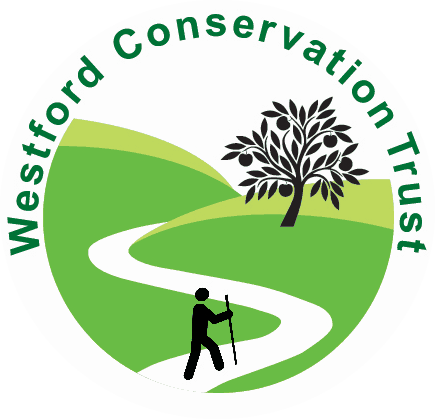
August and September are bird migration months, and we are sad to see them go. Most of our hawks leave us mid-September when wind conditions are right, as do our hummingbirds, warblers and many others. Sometimes we wish that we could follow along as they make the journey, and now we can.
In 2013, Judy Shamoun-Baranes, a Dutch ecologist at the University of Amsterdam developed a radar tool which makes it possible to visualize bird migrations. Her team developed a visualization program in Europe and also one in the United States. Many birds migrate at night so they are very difficult to track without radar. Shamoun-Baranes used data from thirteen weather radars in the Northeast during the fall of 2010. Blue streaks show the movements of many birds together. The tools show direction, altitude, speed and the different routes birds chose on different days. Depending on weather and winds, birds may choose a southwestern route or an eastern route out over the Atlantic Ocean. Different bird species may favor a certain route and wait for the proper winds. Seeing these maps is more than just entertaining. Studying the routes birds take can help pilots avoid strikes and help researchers understand the choices birds make in their routes. You can take a look at one of these maps here: http://timamp.github.io/timamp/v2/case-us.html. You can see Judy Shamoun-Barnes giving an interesting Ted Talk on bird migration on UTube, August, 2016.
One of our champion migrators is the blackpoll warbler. Each fall these tiny birds leave New England and eastern Canada and fly across open water as far south as Argentina. In 2013 and 2014, a UMass Amherst research team led by William DeLuca outfitted thirty-seven blackpoll warblers with geolocators and found that the warblers complete a journey of up to 1721 miles without stops. De Luca states that even though it had long been suspected that blackpolls took this sort of marathon trip, “We were still floored to really see it.” This trip takes about three full days over open ocean, and its risky. If the birds hit bad weather en route, they may run out of fuel and just drop out of the sky. Migrating birds accomplish their missions by fattening up before they leave. In the case of the blackpoll warbler they double their weight, weighing about 16 grams before take off. De Luca states, “They really just turn into flying machines. Fuel and wings and a little navigation computer chip in their head.” DeLuca concludes, “This is one of the longest non-stop overwater flights recorded for a songbird and confirms what has long been believed to be one of the most extraordinary migratory feats on the planet”.
We wish our friends a safe journey, and look forward to their return in the spring.
Many thanks to all flora and fauna reporters for the month of September. Please send reports by October 26 for inclusion in next month’s column. You can write me at 7A Old Colony Drive, call me at 692-3907, or e-mail me at mariancharman@gmail.com.
—————————————
Late August Reports:
Dot Mooney, Monadnock Dr. August 20, turkey vulture flew over. Goldfinch eating a few coneflower seeds, then hopped onto bird bath for a few sips to wash seeds down. August 24, hydrangeas out front attracting so many bumblebees. Early evening, at least seven chipping sparrows and five doves on ground, a chickadee on feeder. August 25, 8:50 pm, a gorgeous yellow full moon rising over back woods. August 27, some pink and white mushrooms growing near stone wall in woods. Saw a hummer visiting nearby hanging plant. Another hummer arrived and they had a brief argument over the flowers, then one chased the other away–typical hummer behavior. August 28, a bunny poking around under feeder.
Doug Pederson, August 25. At Beaverbrook Rd. bridge, osprey catching a fish. [Doug sent a terrific series of photos of the action-MH]
Marian/Bill Harman, Old Colony Drive. August 30, three female turkeys in yard., hummingbird at feeder.
September Reports:
Rosemarie Koester, Providence Rd. September 4. A white hydrangea bush in front covered with so many bees, including bumble bees enjoying the flowers–“Happy to see it”. A new bird in the yard, size of a blue jay, muted striped back, tips of tail white, slender.
Dot Mooney, Monadnock Drive. September 5, a titmouse and Carolina wren on deck, checking out potted plants and having a drink from birdbaths. September 7, watched a hummer visiting geranium on deck, briefly, it was not too impressed. These tiny birds have such long journeys ahead of them. A bit later there was what must have been a family of chipping sparrows exploring lawn and shrubs outside front door. Around noon, a young female downy woodpecker on suet. She seemed unsure of how to get the suet, but finally got the idea. One dove in tree near feeder, quietly fixing her feathers. I can hear nuthatches chatting in the big trees. One grackle stopped by for a few seeds. The clean young female downy returned to suet for more. September 8, along the back lawn, most of the sumac bushes are still green, but some of the leaves are a beautiful red-orange color. September 11, A young red-bellied woodpecker on empty feeder. He must be very confused about that. Chickadees and titmice in and out. I usually notice the first fall colors come out in the vines, then the shrubs, and the trees are last. The fall feast for wildlife is emerging under the power lines. Bears are searching for whatever rich food they can find to fatten up on. My friend on Concord Rd. recently had a bear enjoying sunflower seed in her back yard. Beautiful animals, but I for one will be happy when they are all asleep.
Marian/Bill Harman, Old Colony Dr. September 7, hummingbird at feeder. September 9, what looked to be a red-breasted nuthatch in spruce tree. September 10, huge number of squirrels killed on the roads around town and on the highways (collecting acorns which seem to be more scarce this year), cardinal family with one juvenile, four crows, five goldfinches, two chickadees, titmice, white-breasted nuthatch, downy woodpecker, four grackles, broad-winged hawk came down by street after a squirrel and missed. September 11, three grackles, one red-winged blackbird. September 13, hummingbird seen (last of the year). September 14, grackles, goldfinches feeding babies. September 17, coopers hawk flew down in our back yard and scared up about seven doves, but didn’t catch one. September 23, grackles, crow, catbird on the deck railing, baby bunny eating grass in the yard.
Beth Bonner, Plain Rd. September 11, Mom turkey and her two young came back and went right to the bird feeder. The chicks have grown and obviously remember us. We last saw them on August 11. September 24, turkeys now return up to three times daily. “Each time we see them, Bruce goes out with a coffee can of mixed seed, and dumps it under the feeders. They walk a few feet away and then immediately march right up to eat the food….Last Sunday we saw Mom in our front yard and no chicks. We watched and the two chicks came out of the woods honestly across from us and stopped at the street. We could not hear if Mom was calling them, but all of a sudden they both flapped their wings and half flew across Plain Road…..It has been fun watching the chicks grow and seeing how Mom takes good care of them”.
Mary Lyman at First Parish Church. September 18, pleasantly surprised to see a red-tailed hawk sitting on the roof peak of the meeting house entry. This was my third sighting of it on the property. [Mary sent a photo-MH]
Diane Duane, Howard Rd. September 17, I was excited to see a monarch fly near an empty lot and land on some goldenrod. At home later that day, saw a monarch on our front stand of butterfly bush. Must be heading south from a northern location.
Debbie Prato, Hayrick Lane. September 24, Canada geese, mallards, black ducks, turkeys, white-breasted nuthatches, hairy and downy woodpeckers, goldfinches, house finches, robins, grasshopper sparrows, lots of sharp-shinned, red-tailed and Cooper’s hawks, tiny toad in my vegetable garden.
Len Palmer, at Rome Drive. September 25, Saw an osprey at the heron rookery. I think it is time to go south. There was a bear on Natalie Drive, Chelmsford across Rt. 27.
Marian Harman is a member of the Westford Conservation Trust, a non-profit conservation organization dedicated to the preservation of Westford’s open spaces and trails. The Trust welcomes new members and volunteers. Check out our website at westfordconservationtrust.org and visit us on Facebook.
